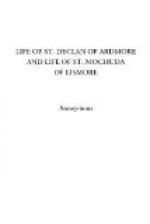The king and his people thereupon compelled Mochuda to proceed on his way. Mochuda did proceed with his disciples, eight hundred and sixty seven in number (and as many more they left buried in Rahen). Moreover, many more living disciples of his who had lived in various parts of Ireland were already dead. All the community abounded in grace: many of its members became bishops and abbots in after years and they erected many churches to the glory of God.
Understand, moreover, that great was the charity of the holy bishop, as the following fact will prove:—in a cell without the city of Rahen he maintained in comfort and respectability a multitude of lepers. He frequently visited them and ministered to them himself—entrusting that office to no one else. It was known to all the lepers of Ireland how Mochuda made their fellow-sufferers his special care and family, and the result was that an immense number of lepers from all parts flocked to him and he took charge and care of them. These on his departure from Rahen he took with him to Lismore where he prepared suitable quarters for them and there they have been ever since in comfort and in honour according to Mochuda’s command.
As Mochuda and his people journeyed along with their vehicles they found the way blocked by a large tree which lay across it. Owing to the density of underwood at either side they were unable to proceed. Some one announced:—“There is a tree across the road before us, so that we cannot advance.” Mochuda said: “In the name of Christ I command thee, tree, to rise up and stand again in thy former place.” At the command of Mochuda the tree stood erect as it was originally and it still retains its former appearance, and there is a pile of stones there at its base to commemorate the miracle.
It was necessary to proceed; the first night after Mochuda’s departure from Rahen the place that he came to was a cell called Drum Cuilinn [Drumcullen], on the confines of Munster, Leinster, and Clanna Neill, but actually within Clanna Neill, scil.:—in the territory of Fearceall in which also is Rahen. In Drum Cuilinn dwelt the holy abbot, Barrfhinn, renowned for miracles. On the morrow Mochuda arrived at Saighir Chiarain [Seirkieran] and the following night at the establishment where Cronan is now, scil.:—Roscrea. That night Mochuda remained without entertainment although it was offered to them by Cronan who had prepared supper for him. Mochuda refused however to go to it saying that he would not go out of his way to visit a man who avoids guests and builds his cell in a wild bog far from men and that such a man’s proper guests are creatures of the wilderness instead of human beings. When Cronan heard this saying of Mochuda he came to the latter, by whose advice he abandoned his hermitage in the bog and he, with Mochuda, marked out the site of a new monastery and church at Roscrea. There he founded a great establishment and there he is himself buried. Mochuda took leave of Cronan and, travelling through Eile [Ely O’Carroll], came to the royal city named Cashel. On the following day the king, scil.:—Failbhe [Failbhe Flann], came to Mochuda offering him a place whereon to found a church. Mochuda replied:—“It is not permitted us by God to stay our journey anywhere till we come to the place promised to us by the holy men.”




